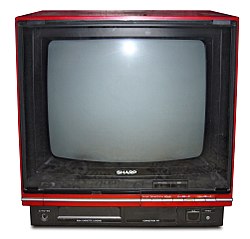Sharp Nintendo Television
 The 14" 14C-C1F model of the C1. | |
| Manufacturer | Sharp |
|---|---|
| Type | Video game console, Television set |
| Lifespan | JPN 1983 - 1989[1] NA 1989-August 14, 1995[1] |
| Media | ROM cartridge ("Game Pak") |
| CPU | Ricoh 2A03 8-bit processor |
| Controller input | 2 controller ports |
| Successor | SF1[2] |
The Sharp Nintendo Television (often described as the C1 NES TV and officially sold as the Game Television; originally released for Japanese markets as My Computer TV C1 (マイコンピュータテレビC1, Mai Konpyuta Terebi C1)) is a television produced by Sharp Corporation with a built-in licensed Nintendo Entertainment System. Originally released in Japan in 1983, the unit was released in the US in 1989. The C1 is notable for having provided the high-quality screenshots displayed in video game magazines of the period, due to its having slightly better picture quality than a Famicom or NES paired with a separate television. The concept was followed up in Japan by the Super Famicom-based SF1 in 1990.
Overview[]
The C1 is a television set developed jointly by Sharp Corporation and Nintendo that features a built-in Nintendo Entertainment System system (originally Famicom). The system was licensed by Nintendo and was released in 1983 to Japanese markets and 1989 to American markets, and supported until 1989.[1] It was noted for having a clearer picture quality than the original setup requiring a Famicom and composite video through an RF Modulator connection. This system used the 2C03 PPU which supports native RGB output for the highest quality picture at a cost of some compatibility and color limitations with games. For this reason, screenshots featured in video game magazines of the time were often taken from the C1.[2]
The system featured two built-in programs, JR GRAPHIC and TV NOTE, and in Japan it was shipped with a multicart containing cut down versions of Donkey Kong Jr. and Donkey Kong Jr. no Sansuu Asobi. At the time of its release, this cartridge was unique to the C1 and represented the only licensed multicart made for the Famicom.[3][4] The second Famicom multicart, Final Fantasy I & II, would be released in 1994 at the end of the Famicom's life.
When the TVs were released in the United States, Nintendo and Sharp used the regular composite output only PPU, the 2C02, for the TVs. While the picture was not as crisp as with the Japanese C-1, this avoided any compatibility issues. Even without the RGB PPU, the picture quality for the U.S. versions of the Sharp TVs were superior to many home console connections because the system was connected via a straight composite signal directly to the TV. Just like the original Nintendo Entertainment System, It also has the 10NES region protection chip. If the game does not load, it would consistently reset, much like a normal NES system; the "P" on the channel indicator would not turn on and off, however, like the original NES's power light.
The Japanese C1 did not have a lockout chip, and it would play any standard Famicom game, or any NES game using an appropriate adapter. Because of the design of the FDS RAM Adapter, due to its shape, users cannot connect the FDS to the C1 without modification, however it is possible to couple NES to Famicom (60 to 72 pin), and Famicom to NES (72 pin to 60 pin) adapters in series, to attach the FDS to the C1.[citation needed]
Because the C1 uses the RGB PPU, and RGB output in general, all C1 systems suffer from the 'NES Jailbars' effect, which is exceptionally pronounced on this system.[citation needed]
Models[]
- 19C-C1F・W (19 inch, retail price ¥145,000)[2]
- 14C-C1F・W・R (14 inch, retail price ¥93,000)[2]
- AN-320 (keyboard only)
- 19SV111 (19 inch)[5] - The North American release known as the Sharp Nintendo Television.
All models came in both a red and a black color.
See also[]
References[]
- ^ Jump up to: a b c ASSEMbler. "Sharp Nintendo Television". ASSEMbler. Archived from the original on April 8, 2002. Retrieved January 17, 2007.
- ^ Jump up to: a b c d Plunkett, Luke (1 April 2011). "This Nintendo Was Inside A Television Set". Kotaku. Retrieved 15 April 2012.
- ^ Sharp C1. FamicomWorld. 2009.
- ^ NEWSCLUB Premium Goods プレミアム グッズ - プレミア付、ってだけで興味あるでしょ? : 金では売れん自慢の一品. Famicom Tsūshin. No.347. Pg.179. 11 August 1995.
- ^ Barnholt, Ray. The Island of Lost Hardware: TVs With an NES Inside. Retronauts. 7 April 2010.
External links[]
- ファミコンテレビC1特集 - TV GAME KAN C1 My Computer TV Feature
- Sharp Nintendo Television at ASSEMbler
- Sharp Famicom TV at the Ultimate Console Database
- Nintendo Entertainment System hardware clones
- Sharp Corporation televisions and displays
- Sharp Corporation games consoles
- Products introduced in 1983
- Television sets


